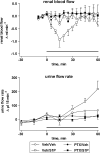Cardiovascular effects of sphingosine-1-phosphate and other sphingomyelin metabolites
- PMID: 15504747
- PMCID: PMC1575924
- DOI: 10.1038/sj.bjp.0705934
Cardiovascular effects of sphingosine-1-phosphate and other sphingomyelin metabolites
Abstract
Upon various stimuli, cells metabolize sphingomyelin from the cellular plasma membrane to form sphingosylphosphorylcholine (SPC) or ceramide. The latter can be further metabolized to sphingosine and then sphingosine-1-phosphate (S1P). Apart from local formation, S1P and SPC are major constituents of blood plasma. All four sphingomyelin metabolites (SMM) can act upon intracellular targets, and at least S1P and probably also SPC can additionally act upon G-protein-coupled receptors. While the molecular identity of the SPC receptors remains unclear, several subtypes of S1P receptors have been cloned and their distribution in cardiovascular tissues is described. In the heart SMM can alter intracellular Ca(2+) release, particularly via the ryanodine receptor, and conductance of various ion channels in the plasma membrane, particularly I(K(Ach)). While the various SMM differ somewhat in their effects, the above alterations of ion homeostasis result in reduced cardiac function in most cases, and ceramide and/or sphingosine may be the mediators of the negative inotropic effects of tumour necrosis factor. In the vasculature, SMM mainly act as acute vasoconstrictors in most vessels, but ceramide can be a vasodilator. SMM-induced vasoconstriction involves mobilization of Ca(2+) from intracellular stores, influx of extracellular Ca(2+) via L-type channels and activation of a rho-kinase. Extended exposure to SMM, particularly S1P, promotes several stages of the angiogenic process like endothelial cell activation, migration, proliferation, tube formation and vascular maturation. We propose that SMM are an important class of endogenous modulators of cardiovascular function.
British Journal of Pharmacology (2004).
Figures



References
-
- ALLENDE M.L., PROIA R.L. Sphingosine-1-phosphate receptors and the development of the vascular system. Biochem. Biophys. Acta. 2002;1582:222–227. - PubMed
-
- ALLENDE M.L., YAMASHITA T., PROIA R.L. G-protein-coupled receptor S1P1 acts within endothelial cells to regulate vascular maturation. Blood. 2003;102:3665–3667. - PubMed
-
- ALTMANN C., FETSCHER C., BÖYÜKBAS D., MICHEL M.C. Contraction of mesenteric resistance vessels by sphingosine-1-phosphate and sphingosylphosphorylcholine in aged rats. Naunyn-Schmiedeberg's Arch. Pharmacol. 2003a;367 Suppl:R57.
-
- ALTMANN C., FETSCHER C., BÖYÜKBAS D., MICHEL M.C. Effects of sphingosine-1-phosphate, sphingosylphosphorylcholine and ceramide on mesenteric artery contraction and relaxation in spontaneously hypertensive rats. Br. J. Pharmacol. 2003b;138 Suppl:157.
-
- ALTMANN C., FETSCHER C., BÖYÜKBAS D., MICHEL M.C. Rat microvessel relaxation by ceramide, isoprenaline and nitroprusside sodium: differential regulation in genetic hypertension and aging. FASEB J. 2003c;17:397.3. - PubMed
Publication types
MeSH terms
Substances
LinkOut - more resources
Full Text Sources
Miscellaneous

